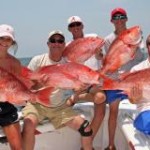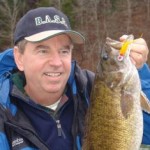Interior Department Proposes Expansion of Hunting, Fishing Opportunities in National Wildlife Refuge System
from The Fishing Wire
Six More Refuges Open to Hunting; 20 Refuges Expand Hunting and Fishing Opportunities
WASHINGTON, D.C. – In advance of National Hunting and Fishing Day on September 28th, Secretary of the Interior Sally Jewell today announced that the U.S. Fish and Wildlife Service is proposing to expand fishing and hunting opportunities throughout the National Wildlife Refuge System, opening up new hunting programs on six refuges and expanding existing hunting and fishing programs on another 20 refuges. The proposed rule also modifies existing refuge-specific regulations for more than 75 additional refuges and wetland management districts.
“Sportsmen and women were a major driving force behind the creation and expansion of the National Wildlife Refuge System more than a century ago and continue to be some of its strongest supporters, especially through their volunteer work and financial contributions,” Jewell said. “Keeping our hunting and angling heritage strong by providing more opportunities on our refuges will not only help raise up a new generation of conservationists, but also support local businesses and create jobs in local communities.”
Under the National Wildlife Refuge System Improvement Act of 1997, the Service can permit hunting and fishing along with four other types of wildlife-dependent recreation where they are compatible with the refuge’s purpose and mission. Hunting, within specified limits, is permitted on more than 329 wildlife refuges. Fishing is permitted on more than 271 wildlife refuges.
Dan Ashe, Director of the U.S. Fish & Wildlife Service, called the proposals “one of the largest expansions of hunting and fishing opportunities on wildlife refuges in recent years.”
“Hunting and fishing are healthy, traditional outdoor pastimes deeply rooted in America’s heritage and have long been enjoyed on hundreds of national wildlife refuges under the supervision of our biologists and wildlife managers,” said Director of the U.S. Fish and Wildlife Service Dan Ashe. “After careful consideration and review from the Service, this proposal represents one of the largest expansions of hunting and fishing opportunities on wildlife refuges in recent years.”
National wildlife refuges generate important benefits from the conservation of wildlife and habitat through spending and employment for local economies. According to the National Survey of Fishing, Hunting and Wildlife-Associated Recreation, published every five years by the Service, more than 90 million Americans, or 41 percent of the United States’ population age 16 and older, pursued wildlife-related recreation in 2011. They spent more than $144 billion that year on those activities. Nearly 72 million people observed wildlife, while more than 33 million fished and more than 13 million hunted.
The Service manages its hunting and fishing programs on refuges to ensure sustainable wildlife populations, while offering historical wildlife-dependent recreation on public lands.
Other wildlife-dependent recreation on national wildlife refuges includes wildlife photography, environmental education, wildlife observation and interpretation.
The Service proposes opening the following refuges to hunting for the first time:
New York
• Shawangunk Grasslands National Wildlife Refuge(http://www.fws.gov/refuge/shawangunk_grasslands/): Open to big game hunting.
Oregon
• Baskett Slough National Wildlife Refuge(http://www.fws.gov/WillametteValley/baskett/): Open to migratory bird hunting.
• Nestucca Bay National Wildlife Refuge(http://www.fws.gov/oregoncoast/nestuccabay/index.htm): Open to migratory bird hunting.
• Siletz Bay National Wildlife Refuge(http://www.fws.gov/oregoncoast/siletzbay/): Open to migratory bird hunting.
Pennsylvania
• Cherry Valley National Wildlife Refuge(http://www.fws.gov/refuge/cherry_valley/): Open to migratory bird, upland game and big game hunting.
Wyoming
• Cokeville Meadows National Wildlife Refuge(http://www.fws.gov/seedskadee/cokevillemeadows.htm): Open to migratory bird, upland game and big game hunting.
Meanwhile, under the proposal, the Service would expand hunting and sport fishing on the following refuges:
California
• Colusa National Wildlife Refuge (http://www.fws.gov/refuge/colusa/): Expand migratory bird and upland game hunting.
Florida
• Arthur R. Marshall Loxahatchee National Wildlife Refuge(http://www.fws.gov/loxahatchee/): Add big game hunting. The refuge is already open to migratory bird hunting.
• St. Marks National Wildlife Refuge (http://www.fws.gov/saintmarks/): Expand migratory bird hunting, upland game hunting and big game hunting.
Idaho
• Kootenai National Wildlife Refuge(http://www.fws.gov/refuge/kootenai/): Expand upland game hunting. The refuge is already open to migratory bird hunting and big game hunting.
Illinois
• Cypress Creek National Wildlife Refuge(http://www.fws.gov/refuge/cypress_creek/): Expand migratory bird hunting, upland game hunting and big game hunting.
• Middle Mississippi River National Wildlife Refuge(http://www.fws.gov/refuge/middle_mississippi_river/): Expand migratory bird hunting, upland game hunting and big game hunting.
Indiana
• Patoka River National Wildlife Refuge and Management Area(http://www.fws.gov/refuge/patoka_river/): Expand migratory bird hunting, upland game hunting and big game hunting.
Iowa
• Neal Smith National Wildlife Refuge(http://www.fws.gov/refuge/Neal_Smith/): Expand migratory bird hunting, upland game hunting and big game hunting.
• Northern Tallgrass Prairie National Wildlife Refuge(http://www.fws.gov/refuge/northern_tallgrass_prairie/): Expand migratory bird hunting, upland game hunting and big game hunting.
• Port Louisa National Wildlife Refuge(http://www.fws.gov/refuge/port_louisa/): Expand migratory bird hunting, upland game hunting, big game hunting and sport fishing.
Maine
• Rachel Carson National Wildlife Refuge(http://www.fws.gov/refuge/rachel_carson/): Expand migratory bird hunting, upland game hunting and big game hunting.
Missouri
• Mingo National Wildlife Refuge (http://www.fws.gov/refuge/mingo/): Expand migratory bird hunting, upland game hunting and big game hunting.
New Mexico
• San Andres National Wildlife Refuge(http://www.fws.gov/southwest/refuges/newmex/sanandres/): Expand big game hunting.
Oregon
• Bandon Marsh National Wildlife Refuge, OR and WA(http://www.fws.gov/oregoncoast/bandonmarsh/index.htm): Expand migratory bird hunting. The refuge is also already open to sport fishing.
• Julia Butler Hanson Refuge for the Columbian White-Tailed Deer, OR and WA (http://www.fws.gov/jbh/): Expand migratory bird hunting. The refuge is already open to big game hunting.
• Malheur National Wildlife Refuge (http://www.fws.gov/malheur/): Expand migratory bird hunting and sport fishing. The refuge is already open to upland game hunting and big game hunting.
Texas
• Aransas National Wildlife Refuge (http://www.fws.gov/refuge/aransas/): Add migratory bird hunting. The refuge is already open to big game hunting.
• Balcones Canyonlands National Wildlife Refuge(http://www.fws.gov/refuge/balcones_canyonlands/): Expand hunting for migratory birds, upland game and big game.
Vermont
• Silvio O. Conte National Fish and Wildlife Refuge(http://www.fws.gov/r5soc/): Expand migratory bird hunting, upland game hunting and big game hunting.
Washington
• Willapa National Wildlife Refuge (http://www.fws.gov/refuge/willapa/): Expand migratory bird hunting and big game hunting. The refuge is already open to upland game hunting.
Notice of the 2013-2014 proposed Refuge-Specific Hunting and Sport Fishing Regulations will publish in the Federal Register September 24, 2013. Written comments and information can be submitted by one of the following methods:
• Federal eRulemaking Portal (http://www.regulations.gov/) Follow the instructions for submitting comments to Docket No. [FWS-HQ-NWRS-2013-0074];
or
• U.S. mail or hand-delivery: Public Comments Processing, Attn: [ FWS-HQ-NWRS-2013-0074]; Division of Policy and Directives Management; U.S. Fish and Wildlife Service; 4401 N. Fairfax Drive, MS 2042-PDM; Arlington, VA 22203.
Comments must be received within 30 days, on or before October 24, 2013. The Service will post all comments on regulations.gov. The Service is not able to accept email or faxes.
Comments and materials, as well as supporting documentation, will also be available for public inspection at regulations.gov under the above docket number. In addition, more details on the kinds of information the Service is seeking is available in the notice.
To view a complete list of all hunting/sport fishing opportunities on refuges, click here (http://www.fws.gov/refuges/hunting/huntFishRegs.html).



